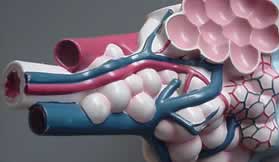
Hide internal view.

Hide internal view.
The lungs Filtering the air. |
|
|
The windpipe (trachea) has rings of supporting cartilage that stop the windpipe from collapsing and suffocating the animal. Click to see a 120kb video of the mucus lining the wall of the trachea. |
|
| The air we
breathe is full of pollutants, dust particles, bacteria and viruses. If
all these particles were allowed to enter the lungs they would quickly block
the fine bronchioles and suffocation would result. If bacteria were to enter
the lungs massive infection will take place. The lungs have a very efficient air filtering system. The trachea is lined with cells that produce mucus(goblet cells)and other cells that have fine hair like projections (cilia). Sticky mucus is pumped into the cavity of the trachea. Bacteria, dust and viruses stick to the mucus as they enter deeper into the trachea. The dust filled mucus is swept upwards by the fine hair-like projections. This entire process is going on all the time without us having to be consciously involved. The only time we are aware of the mucus coming to the top of the trachea is when we use force to clear our throat by a reflex action, cough. |
 |
| If any dust particle, bacteria or virus manages to get through to the alveolus they are dealt with swiftly by white blood cells (macrophage). Macrophages patrol very close to the surface of the alveolus and enter its thin walls when an invader is detected. The macrophage quickly engulfs and digests the intruder. | |